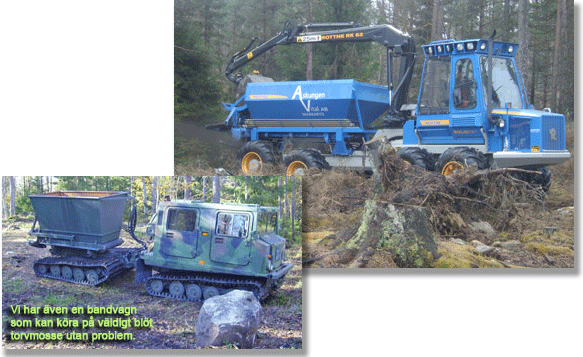|
About dissemination
|
|
| |
Back to the forest
Last but not least, we spread the ashes in the forest, in
areas planned in cooperation with the Forestry Board. This
cooperation ensures that it never spread ashes on sensitive
land, or other nature that may be damaged.
The Forestry Board send us digital maps that we have in the
machine's GPS. As the ashes spread, we draw it on the map so
we can see what areas we have been at. In this way, the
landowner easily can see where the ashes have been spread.
Normal amount of spread is 3 tonnes of ash per hectare.
In anticipation of the spread of forest, ash need sometimes
be stored. Intermediate storage of ashes or finished ash
product should be done so that leaching is minimized. The
storage location should be dry and remain relatively high in
the terrain. Permanent middle layer should have hard-surface
and access to water and wave. The actual spread have to be
done in such a way that damage to soils and vegetation is
avoided. The ash should be spread out evenly. Ash recycling
should (like nitrogen fertilization) not occur in or near
sensitive areas.
|
|
| |
Areas
where ash recycling is not allowed
Ashes should not be spread over:
¤ Lake and Streams
¤ Wetlands with high natural and cultural values
¤ Formally protected land
¤ Key biotopes (Woodland key- habitat of rare and endangered
species)
¤ Personal property
¤ Someone elses property and road
An ash-free zone from
these places is 25 meters, in addition to
someone elses property and road, in which it shall be 10
meters.
|
|
| |
Explanation
Although the purpose of the ashes is to improve the chemical
state, ash which falls directly into the water can harm the
environment. This is due primarily to the fact that aquatic
organisms can be damaged by the ash initial salt effect.
The ash also contains substances that may be harmful to
aquatic organisms on the high dose ports directly in the
aquatic environment. In direct proximity to water its often
high nature values. Therefore, an ash-free zone should be
provided around all lakes and rivers. An ash-free zone
should also be given to wetlands with high nature, key
biotopes and land. Ash recycling in connection to formally
protected land, should also be an ash-free zone provided.
Ashless zones shall also be given to someone elses property
and roads.
If these don´t have any special nature, it is
sufficient, however, with a zone of 10 meters. Ash recycling
can be done on fresh clearings where there are fields of
vegetation which can take up the industry and prevent
leaching, or the ash is so well tempered and dissolves so
slowly that the extra leaching from it become
insignificant.
In the nitrogen-rich soils should ash recycling done in such
a way that it does not lead to increased nitrogen leaching.
Studies shows that ash recycling do not cause an increase in
nitrate leaching. But for safetys sake it is best to wait
until there is established field vegetation on the final
felled area, which can take up any nitrogen released.
|
|
| |
 |
|
|